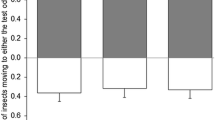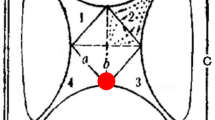Abstract
Dung beetles of the Scarabaeinae subfamily are present in temperate and tropical ecosystems. Some species of these insects feed on millipede carcasses. The objective of this study was to determine the attraction of Canthon vazquezae to volatiles released by Messicobolus magnificus. The bioassay was performed using a Y-glass tube olfactometer. Canthon vazquezae was significantly attracted to dead M. magnificus, as well as stressed and wounded individuals. In contrast, unstressed M. magnificus did not attract C. vazquezae. The volatiles released by M. magnificus in stressed, wounded, and dead states were analyzed by gas chromatography coupled to mass spectrometry (CG-MS). Six compounds were tentatively identified as 2-methyl-p-benzoquinone, trimethyl-p-benzoquinone, 1,2,4-trimethoxybenzene, 2-methyl hydroquinone, 2,5-dimethoxythiophenol, and 3,4-dimethoxyphenol. Some of these compounds have been identified as attractants to other coleopterans.


Similar content being viewed by others
References
Aldrich JR (1995) Chemical communication in the true bugs and parasitoid exploitation. In Chemical ecology of insects 2. Springer, Boston
Bedoussac L, Favila ME, López RM (2007) Defensive volatile secretions of two diplopod species attract the carrion ball roller scarab Canthon morsei (Coleoptera: Scarabaeidae). Chemoecology 17:163–167
Blum MS (1981) Chemical fefenses of arthropods. Academic Press, New York
Brühl C, Krell FT (2003) Finding a rare resource: Bornean Scarabaeoidea (Coleoptera) attracted by defensive secretion of diplopoda. Coleopt Bull 57:51–55
Cano EB (1998) Deltochilum valgum acropyge bates (Coleoptera: Scarabaeidae: Scarabaeinae) habits and distribution. Coleopt Bull 52:174–178
CCA (2015) Cañón del Sumidero II: expediente de hechos relativo a la petición SEM-11-002, Comisión para la Cooperación Ambiental, Montreal, 98
Halffter G, Halffter V (2009) Why and where coprophagous beetles (Coleoptera: Scarabaeinae) eat seeds, fruits, or vegetable detritus. Boletin de la S E A 45:1–2
Hanski I, Cambefort Y (1991) Dung beetle ecology. Princeton University Press, Princenton, p 481
Hoffman RL (1990) Diplopoda. In: Dindal DL (ed) Soil biology guide. Wiley, New York, pp 835–860
Kohlmann BA, Solís A (2002) El género Canthon (Coleoptera: Scarabaeidae) en Costa Rica. Gior Ital Entomol 10:1–68
Köpf A, Rank NE, Roininen H, Tahvanainen J (1997) Defensive larval secretions of leaf beetles attract a specialist predator Parasyrphus nigritarses. Ecol Ent 22:176–183
Krell FT (1999) Southern African dung beetles (Coleoptera: Scarabaeidae) attracted by defensive secretion of Diplopoda. Afr Entomol 7:287–288
Krell FT (2004) East African dung beetles (Scarabaeidae) attracted by defensive secretion of millipedes. J East African Nat Hist 93:69–73
Krell FT, Scmitt T, Krämer F (1996) Scarab beetles (Coleoptera: Scarabaeoidea) specialized on diplopod carcasses (Myriapoda: Diplopoda) Tenth International Congress of Myriapodology Copenhagen Abstracts of lectures and posters 35
Krell FT, Schmitt T, Linsenmair KE (1997) Diplopod defensive secretions as attractants for necrophagous scarab beetles (Diplopoda; Insecta, Coleoptera: Scarabaeidae). Ent Scand Suppl 51:281–285
Krell FT, Schmitt T, Dembele A, Linsenmair KE (1998a) Repellents as attractants- extreme specialization in afrotropical dung beetles (Coleoptera: Scarabaeoidea) as a competition avoiding strategy. Zoology, Analysis of Complex Systems 101(Supplement 1):12
Krell FT, Schmitt T, Linsenmair KE (1998b) Repellents as attractants-extreme specialization in Afrotropical dung beetles (Coleoptera: Scarabaeidae) as competition avoiding strategy. Zoology 101(Suppl. 1):12
Larsen TH, Forsyth A (2005) Trap spacing and transect design for dung beetles biodiversity studies. Biotropica 37:322–325
Larsen TH, Lopera A, Forsyth A, Génier F (2009) From coprophagy to predation: a dung beetle that kills millipedes. Biol Lett 5:152–155
Mesa-Díaz JA, Tacoronte-Morales JE, Montes de Oca PR, Tobellas SJ, Garrida AR (2009) Primer reporte de 3,4-dimethoxyfenol, en secreciones defensivas de milípedos endémicos cubanos (Spirobolida: Rhinocricidae, Rhinocricus). Caso de estudio Rhinocricus duvemoyi Karch 1881, población de La Palma. CENIC 40:27–29
Nichols E, Spector S, Louzada J, Larsen T, Amezquita S, Favila ME (2008) Ecological functions and ecosystem services provided by Scarabaeinae dung beetles. Biol Conserv 141:1461–1474
Rivera-Cervantes LE, Halffter G (1999) Monografía de las especies mexicanas de Canthon del subgénero Giaphyrocanthon (Coleoptera: Scarabaeidae: Scarabaeinae). Acta Zool Mex 77:23–150
Rocha DFO, Wouters FC, Zampieri DS, Brocksom TJ, Machado G, Marsaioli AJ (2013) Harvestman phenols and benzoquinones: characterisation and biosynthetic pathway. Molecules 18:11429–11451
Rodríguez J, Jones TH, Sierwald P, Marek PE, Shear WA, Brewer MS, Kocot KM, Bond JE (2018) Step-wise evolution of complex chemical defenses in millipedes: a phylogenomic approach. Sci Rep 8:3209
Rodríguez-López ME, Sánchez-Hernández G, Gómez B (2019) Escarabajos coprófagos (Coleoptera: Scarabaeidae: Scarabaeinae) en la reserva El Zapotal, Chiapas, México. Rev Peru Biol 26:339–350
Sánchez-Hernández G, Gómez B, Delgado L, Rodríguez-López ME, Chamé-Vázquez ER (2018) Diversidad de escarabajos copronecrófagos (Coleoptera: Scarabaeidae: Scarabaeinae) en la Reserva de la Biosfera Selva El Ocote, Chiapas, México. Caldasia 40:144–160
Sánchez-Hernández G, Agustín-Sánchez J, Bueno-Villegas J, Gómez B (2019) Utilizando un recurso inusual: escarabajos del estiércol atraídos a milpiés (Diplopoda: Spirobolida). Rev Peru Biol 26:499–502
Schmitt T, Krell FT, Linsenmair KE (2004) Quinone mixture as attractant for necrophagous dung beetles specialized on dead millipedes. J Chem Ecol 30:731–740
Silva FAB, Vidaurre T, Vaz-de-Mello F, Louzada J (2012) Predatory behaviour in Deltochilum: convergent evolution or a primitive character within a clade? J Nat Hist 46:1359–1367
Solís A, Kohlmann B (2002) El género Canthon (Coleoptera: Scarabaeidae) en Costa Rica. Gior ItalEntomol 10:1–68
Stowe MK, Turlings TCJ, Loughrin JH, Lewis WJ, Tumlinson JH (1995) The chemistry of eavesdropping, alarm, and deceit. Proc Natl Acad Sci U S A 92:23–28
Tacoronte MJE, Cabrera PMT (2019) Diplodomica I. Chemical composition of repugnatorial secretions of Cuban endemic millipede gen. Rhinocricus sp. Procedings 41:73-80. Presented at the 23rd International Electronic Conference on Synthetic Organic Chemistry, 15 November–15 December 2019; Available online: https://ecsoc-23.sciforum.net/
Villalobos FJ, Diaz A, Favila ME (1998) Two species of Canthon Hoffmanns egg (Coleoptera: Scarabaeidae) feed on dead and live invertebrates. Coleopt Bull 52:101–104
Vujisić LV, Antić DZ, Vucković IM, Sekulić TL, Tomić VT, Mandić BM, TeTešević VV, Ćurčić BP, Vajs VE, Makarov SE (2014) Chemical defense in millipedes (Myriapoda, Diplopoda): do representatives of the family Blaniulidae belong to the 'quinone' clade? Chem Biodivers 11:483–490
Wilson H (2006) Juliformian millipedes from the lower Devonian of Eur- america: implications for the timing of millipede cladogenesis in the Paleozoic. J Paleontol 80:638–649
Acknowledgments
We thank the staff of the Cañón del Sumidero National Park for the logistical support during the development of the field work. Also, to the Chemical Ecology Laboratory of El Colegio de la Frontera Sur (ECOSUR), Tapachula campus, for the support during the development of the present investigation.
Funding
This research was carried out thanks to the financing of El Colegio de la Frontera Sur (ECOSUR), and a master’s scholarship granted to C. Misraim Edivaldo Rodríguez López, by the Council of Science and Technology (CONACYT) CVU number: 781562.
Author information
Authors and Affiliations
Contributions
Misraim Edivaldo Rodríguez López: Organized the logistics, carried out the field work, the taxonomic determination of C. vazquezae, database, laboratory bioassays, analyzed the data and wrote the manuscript. Benigno Gómez y Gómez: Carried out the conceptualization and design of the field work and wrote the manuscript. Julián Bueno Villegas: Made the taxonomic determination of M. magnificus and wrote the manuscript. Edi Álvaro Malo Rivera: Performed the conceptualization and design of the laboratory and field work, drafted the manuscript. All authors reviewed and approved the manuscript.
Corresponding author
Ethics declarations
Conflict of Interests
The authors declare do not incur in conflict of interest.
Additional information
Publisher’s note
Springer Nature remains neutral with regard to jurisdictional claims in published maps and institutional affiliations.
Rights and permissions
About this article
Cite this article
Rodríguez-López, M.E., y Gómez, B.G., Bueno-Villegas, J. et al. Attraction of Canthon vazquezae (Coleoptera: Scarabaeinae) to Volatiles Released by Messicobolus magnificus (Diplopoda: Spirobolida). J Insect Behav 34, 255–263 (2021). https://doi.org/10.1007/s10905-021-09785-x
Received:
Revised:
Accepted:
Published:
Issue Date:
DOI: https://doi.org/10.1007/s10905-021-09785-x




